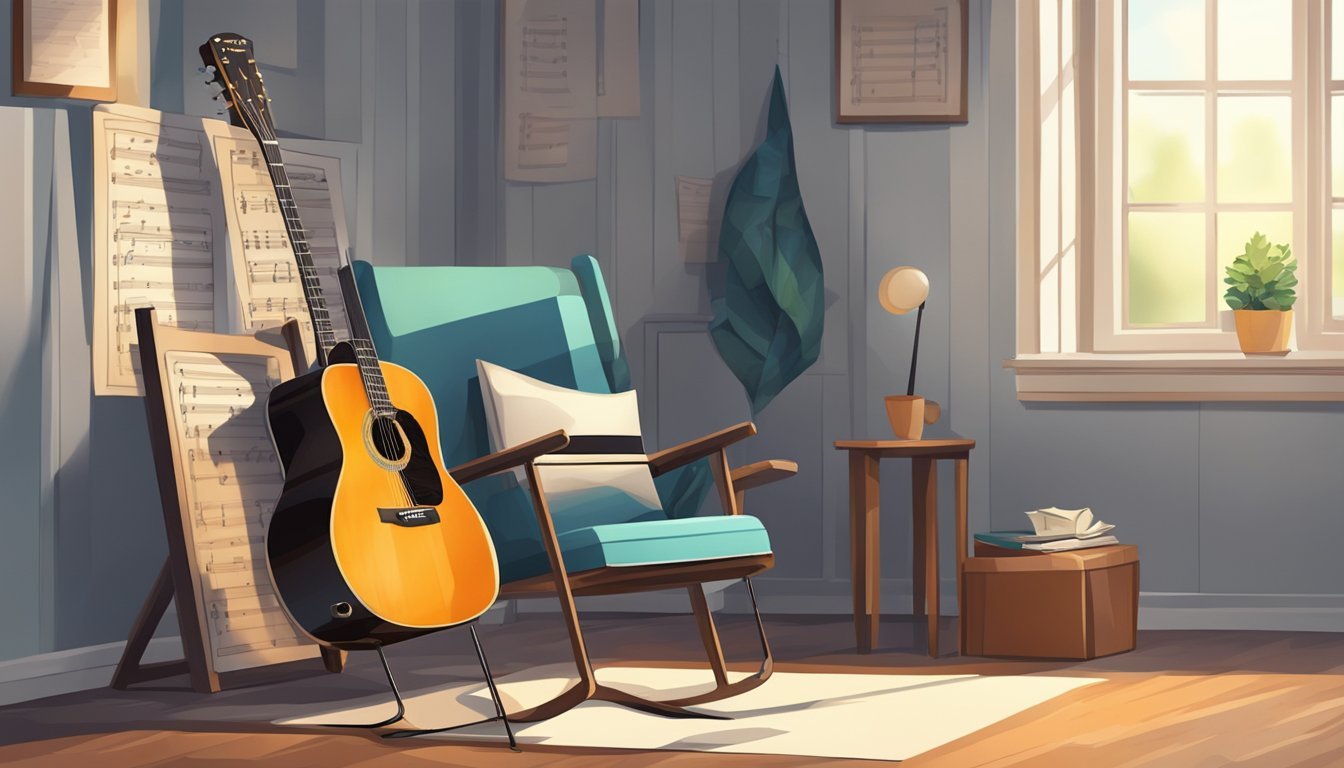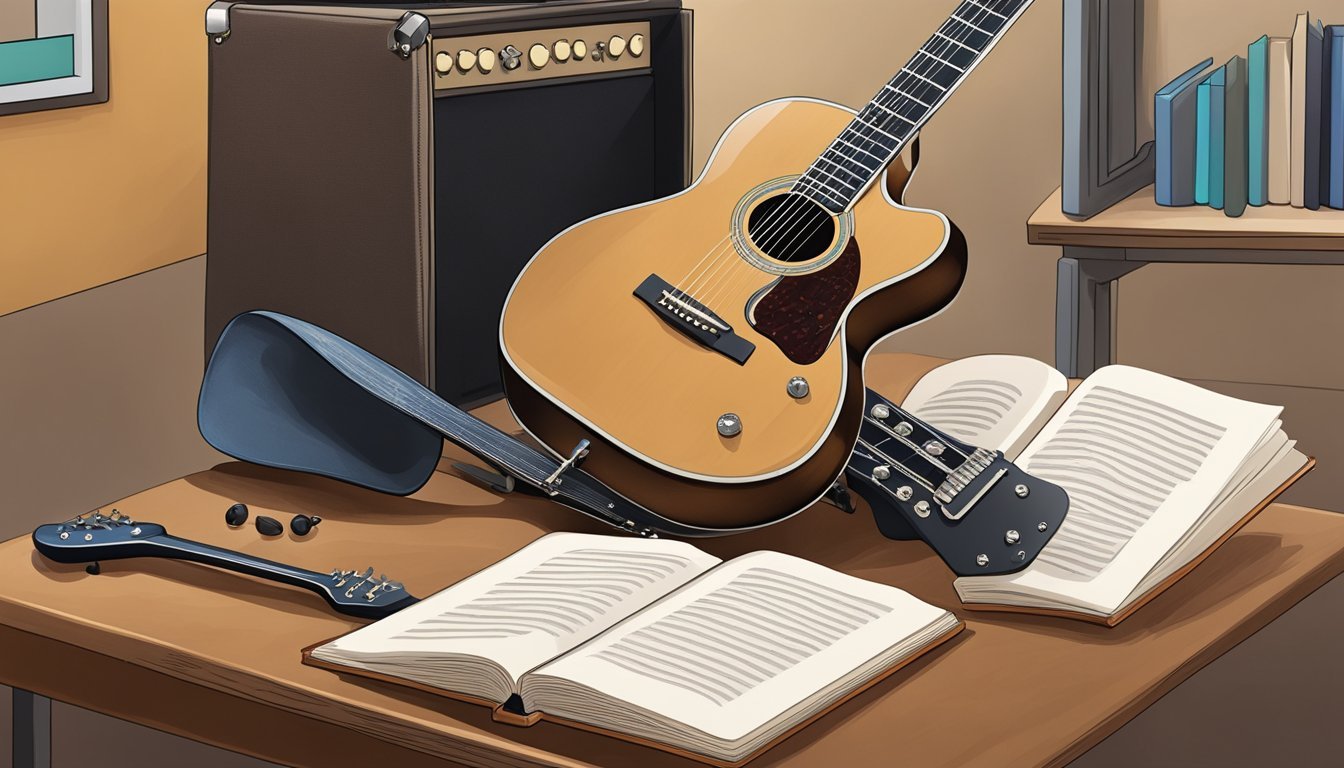Many people find learning to play guitar daunting.
Your experience will largely depend on your goals and how much effort you’re willing to put in.
Whether you’re dreaming of strumming along to your favorite songs or aiming for intricate solos, the journey can be rewarding if approached with the right mindset.

Starting out may be challenging.
Many beginners face some pain in their fingers and confusion around chords.
However, as you practice consistently, it becomes easier and more enjoyable, allowing you to express yourself through music.
As you advance, you’ll find that the skills you gain can lead to a lot of fun and creativity.
With dedication and the right methods, you can make great progress and enjoy making music for years to come.
Key Takeaways
- Setting clear goals makes learning guitar easier.
- Regular practice helps you improve faster.
- Enjoying the process makes playing more rewarding.
Getting Started with Guitar

Learning to play guitar can be exciting yet a bit overwhelming.
Choosing the right guitar and setting up the right environment makes a big difference in how quickly you’ll learn and enjoy playing.
Choosing the Right Guitar
Selecting the right guitar is crucial for beginners.
You’ll mainly choose between an acoustic guitar and an electric guitar.
Acoustic guitars are great for their simplicity and portability.
They don’t need extra equipment.
On the other hand, electric guitars offer more versatility with sounds but require amplifiers.
When choosing, consider your comfort and how each type feels in your hands.
Visit a store to try a few.
Pay attention to how you hold the guitar and ensure it feels natural.
Your choice will impact your learning experience.
Fundamentals of Guitar Basics
Once you have your guitar, focus on the basics.
Start by learning how to hold the guitar properly.
Your hands should be relaxed, with your fingers on the fretboard without tension.
After you feel comfortable with your grip, you can begin to explore simple chords and strumming patterns.
This foundational practice will help you as you learn more complex songs like how to play thunderstruck, which is a great piece to challenge your skills and build your confidence.
Remember to practice regularly, and don’t be afraid to make mistakes along the way!
Next, get familiar with essential parts of the guitar:
- Fretboard: Where you press down the strings.
- Strings: There are six strings, each with a different note.
- Body: It affects the sound. The shape and material can vary.
Practice simple chords first.
They are the building blocks for many songs.
Spend time on tuning as well.
A well-tuned guitar makes everything sound better, so invest in a tuner if needed.
Setting Up an Ideal Learning Environment
Creating a good learning space helps you stay focused.
Choose a spot that is quiet and has good lighting.
Make sure you can sit comfortably with your guitar.
Having the right tools can also aid your practice.
Consider getting:
- A metronome to help with timing.
- A music stand for keeping your sheet music or tabs in view.
- Quality earbuds or speakers for listening to lessons or backing tracks.
Make it a routine to practice in this space daily.
Consistency is key to improvement.
Before you know it, you’ll be strumming away!
Learning and Practice
Learning to play guitar requires dedication and a steady approach to practice.
Establishing a routine and using various resources can make this journey enjoyable and effective.
Here are some key aspects to focus on.
Developing a Practice Routine
Creating a consistent practice routine is key for learning guitar.
Aim for at least 30 minutes a day, even if it’s broken into shorter sessions.
This regular practice builds muscle memory and helps you become comfortable with basic chords and barre chords.
Start by warming up.
Simple exercises like finger stretches can prepare you for playing.
Then, include time for learning new songs and techniques.
Mixing in fun songs with your practice can keep you motivated.
Track your progress.
Keeping a journal about what you practice can help you stay focused and measure growth.
Understanding Practice Techniques
To improve your guitar skills, you must understand effective practice techniques.
Focus on one skill at a time, whether it’s chords, strumming patterns, or finger exercises.
Use a metronome to work on your timing.
Start slow and gradually increase your speed as you get comfortable.
Try playing along with songs to learn timing and rhythm.
This can make practicing more engaging.
Websites and apps like Yousician offer interactive methods to learn songs while pushing you to improve.
Regularly challenge yourself with new techniques, but don’t forget to revisit what you’ve already learned to strengthen your foundation.
Online Guitar Lessons and Resources
Online resources can be a game changer for learning guitar.
Programs like YouTube have countless tutorials, from beginner to advanced techniques.
You can try platforms like Yousician, which provide guided lessons.
They teach you notes, chords, and even songs, making your learning experience interactive.
Don’t overlook forums and online communities.
Many self-taught guitar players share tips and resources.
Connecting with others can help you solve problems and stay motivated.
Experiment with different resources.
Find what works for you and make your learning journey enjoyable!
Advancing Your Guitar Skills
As you progress on your guitar journey, it’s essential to focus on both advanced techniques and music theory.
This knowledge will help you play better and enjoy the instrument more.
You can also enhance your skills through performance and collaboration with other musicians.
Mastering Advanced Techniques
To really take your playing to the next level, you should explore advanced techniques.
These can include hammer-ons, pull-offs, and string bending.
- Hammer-ons: This technique lets you play a note without picking it again.
- Pull-offs: This involves pulling your finger off a fretted note to let the next note ring.
Both techniques improve speed and fluidity.
Don’t forget about tapping and sweep picking, which can add a lot of flair to your solos.
Practice these methods slowly at first, then build up speed.
The key is consistent practice and patience.
Exploring Music Theory and Guitar Tricks
Understanding music theory can tremendously enhance your playing.
Start with basic concepts like scales and chords.
Knowing how they work together will help you create your own music.
- Scales: Familiarize yourself with major and minor scales. These provide the foundation for solos.
- Chords: Learn how to construct and transition between different chords smoothly.
Also, don’t overlook fun guitar tricks to impress your friends. Harmonics and palm muting can create unique sounds.
Use these techniques when establishing solos or riffs to elevate your playing style.
Performance and Playing with Others
Playing live or jamming with friends can boost your confidence and skills.
It will also expose you to new styles and techniques.
When performing, focus on timing and dynamics.
Make eye contact with your audience to build a connection.
It’s also helpful to record yourself to identify areas for improvement.
Jamming with other musicians encourages collaboration.
You can exchange ideas and learn from each other.
Both experiences will sharpen your skills and make you a more versatile player.
Frequently Asked Questions
Learning guitar can feel like a different journey compared to other instruments.
There are unique challenges and benefits that come with picking up the guitar.
Here’s a closer look at these common questions.
Why do some people find guitar more difficult than piano?
Many people find the guitar harder due to its physical demands.
You need to develop finger strength and coordination to press down the strings, which can be tough for beginners.
On the piano, your fingers mainly move up and down keys, making it somewhat easier to get started.
What makes guitar challenging for beginners?
Beginners often struggle with finger placement and strumming techniques.
It takes time to build up calluses on your fingertips.
Additionally, learning to read music or chord charts adds another layer of complexity that can feel overwhelming.
Can adults pick up guitar skills easily or does it get tougher with age?
Adults can certainly learn guitar, but it might come with more challenges.
You may have less time to practice compared to a teen.
However, many adults bring better focus and dedication to lessons, which can help them progress.
Does self-teaching guitar make the learning process harder?
Self-teaching can make it tricky to develop proper techniques.
Without guidance, you might form bad habits that are hard to break.
However, many resources are available online that can help you teach yourself effectively.
Is the time investment in learning guitar substantial?
Yes, learning guitar requires a significant time commitment.
Practicing consistently, even for just 10 to 15 minutes a day, is essential to see improvement.
Those who invest time and effort usually see better results.
What are the pros and cons of starting guitar lessons in your 30s?
Starting lessons in your 30s has its perks.
You may be more focused and committed.
However, it can be harder physically, and you may have competing responsibilities.
Balancing learning with work and family can be challenging but doable.

